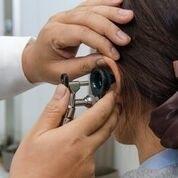What are Chronic Ear Infections?

A chronic ear infection is an infection that does not heal for a long period of time, or recurs. It is also known as recurrent otitis media. Chronic ear infections affect the middle ear.
The middle ear is the part just behind the ear drum. The Eustachian tube connects your middle ear to the back of your throat. The tube is responsible for draining fluid in your middle ear. But if this tube gets blocked, fluid collects in the middle ear, pressurizing the ear drum and thereby causing ear pain and sometimes discharge.
Children are at greater risk for infection due to the narrow and horizontal shape of the Eustachian tube.
What are the signs and symptoms of a chronic ear infection?
Symptoms of a chronic ear infection are mild compared to an acute infection, as they can persist for a longer period of time, and may be intermittent. The signs and symptoms that indicate you have a chronic ear infection include:
- Ear pain
- Ear discharge
- A sensation of increased pressure in the ear
- Difficulty hearing
- Difficulty sleeping
- Fever
Babies who cannot communicate will show a nonspecific set of symptoms like poor feeding, fever, tugging of the ears, crying more than usual, and difficulty sleeping.
What is the treatment?
A chronic ear infection can be treated with medication as well as some home treatment options.
Home treatments include:
- Over the counter pain killers such as paracetamol to relieve pain
- Ear drops for numbing the area
- Hold a warm or cold cloth over pain induced areas
Chronic ear infections are usually a result of a bacterial infection, therefore your doctor will prescribe antibiotics for the infection. If there is a perforation in the ear drum, then ear drops will be given to you as well.
If the ear infection does not seem to settle with medical treatment, then your doctor will recommend surgery. This surgery is known as a myringotomy. It is a very simple, common, and a safe surgery that is done as an outpatient procedure. During this surgery, your doctor will make a tiny incision in the ear drum with the help of a surgical microscope, and an ear tube will be inserted through this hole. The ear tube functions as a passage for air to enter your middle ear as well as for the collected fluid in the middle ear to drain out. As soon as the fluid drains out, sometimes hearing can be restored immediately. This tube fall off on its own, and the incision in the ear drum will heal after a few days.
It is very important that your child gets treatment for their ear infections as it could affect their hearing, and cause speech and language problems.
What happens if you don’t treat the infection?
Several complications can arise if you do not treat the ear infection. Some complications include:
- Impairment in hearing (In rare cases, complete deafness in the ear)
- Problems with balance
- Language and speech problems in children
- Perforation of the ear drum
- Infection can spread to your brain
- Damage to the middle ear bones











